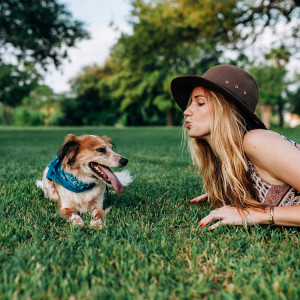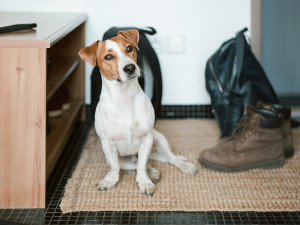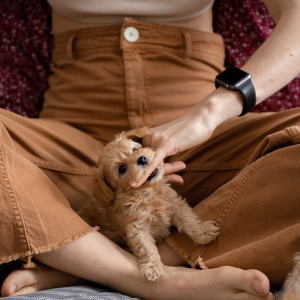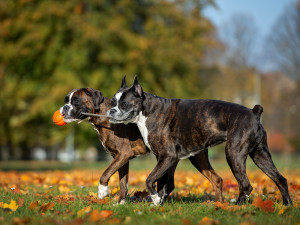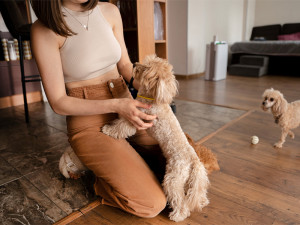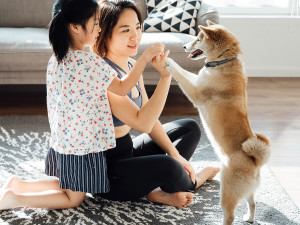How to Stroke a Dog – Yes, You Do Need Lessons
There’s a difference between being affectionate and being annoying
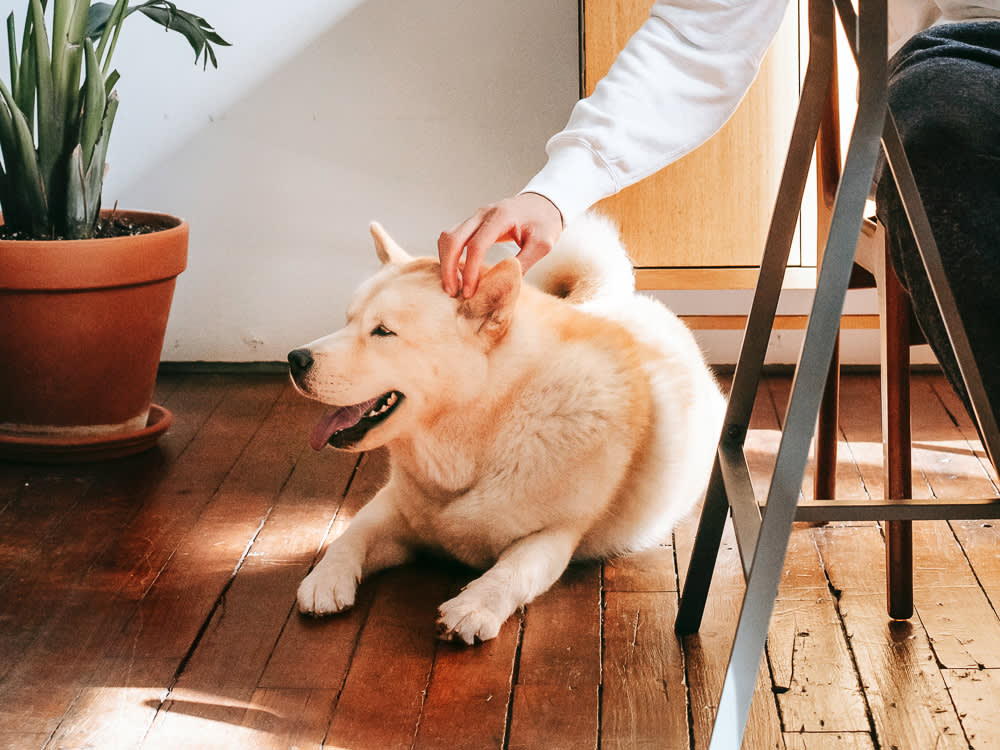
Share Article
You can always tell when someone is a dog lover. At the sight of a pup, we light up, stroke them and make their absolute day. Those ear scratches can make you a dog’s best friend forever – and sometimes they won’t ever let you stop (not that you’re complaining).
We’ve convinced ourselves that all dogs want to be stroked. They love it. And it’s good for them, too. So, we reach out a little too greedily, eager for the validation of that unconditional return of affection. Unfortunately, we have it all wrong, says animal behaviourist William Berloniopens in a new tab, who trains rescue dogs to perform on stage and screen. So, what’s the proper way to stroke a dog, especially one you’ve never met before? Read on to find out.

littleKin™ is Kinship’s home just for puppy and kitten parents. Bop over to check out expert advice, new pet tools, and special deals—all curated for your newest family member.
opens in a new tabHow to stroke a dog you’ve never met
Some dogs want all the attention. Others endure strangers’ clumsy overtures with grace. But quite a few land somewhere in between annoyed and totally freaked out. So why do dogs, who are perfectly capable of sinking their teeth into our skin, put up with us? “Because they are better creatures than we are,” says Berloni. “We’d slap or kick or file a lawsuit if a stranger touched us – we wouldn’t be as forgiving!”
Do let them sniff your hand first
Feeling a little defensive – especially when I remember how many times I’ve been told that dogs don’t like to be stroked on the head and have done it anyway – I ask how he greets a dog for the first time. “I look at the dog, smile and say: ‘Hi, how are you?’ If the dog approaches, I’ll put my hand out, and if they solicit with more than a sniff, I’ll give it to them,” he says. “But it’s all based on their cue. Some dogs, like Terriers, like to check you out for a while. Hunting dogs will sniff; they might not want to be stroked, but they’ll put up with it while they sniff you.”
What about dogs who come bounding up eager to interact? “That’s like someone extending a hand,” says Berloni. “It’s the beginning of creating a relationship, but it has nothing to do with touching them. If you watch dogs interact, they’re reacting to each other’s signals: sniff, approach, play, attack. I grew up on a farm. My pets were my companions so I learnt how to play their games so they would hang out with me.”
Trainer Marilyn Pona did the same, coaxing a surly local Chow Chow into friendship. “If you really look at dogs, unless they’re having a moment of play, they don’t touch each other,” she says. “It’s something we can offer them that they don’t have in their world. And it does please them.” Just not always, automatically and across the board.
Don’t grab their face
Figuring out how to interact with a dog you’ve never met before isn’t that hard when you take a step back, Berloni says. “When I meet a stranger, I don’t grab them. And when I’m going to kiss somebody, I don’t grab them around the neck with two hands.” That’s one of his pet peeves when it comes to stroking a dog: “People take two hands, scrunch the dog’s neck, scratch their ears, thinking that is enjoyable to them. It’s too much! It’s like your aunt pinching your cheeks.”
When Berloni trains a dog for someone to work with, he’ll say: “OK, now you have to bond with them.” And what do they do? “They go down on their knees and rub the dog all over, which makes the dog get silly,“ he says. “When we’re very vigorous with them, that’s an invitation to play and it’s not relaxing at all. If you want to soothe a dog, think about what a mama dog does. She licks her puppies, gently and calmly, and she goes with the grain of the fur.”
How to read a dog’s cues
Randy Grim, author of Don’t Dump the Dogopens in a new tab, winces every time he hears someone say “all dogs love me” or “you just have to look at the expression on their face”. You’re gonna get bitten, he’s thinking. “Leave reading a dog’s face to the experts. That takes a special knack,” he says. “I’m good at it because I’ve been around them forever. But it’s hard. If a dog is panting, people can mistake it for a smile when it’s really anxietyopens in a new tab. That crinkled-face look can be curiosity, not aggressionopens in a new tab.” Read their body, not their face, he suggests. Does the dog seem approachable, maybe panting but with the tail wagging, the hackles down, the bum wiggling?
“A lot of dogs are hand-shy because they’ve been over-touched,” says Pona. “Fingertip touching, I think, is best. And look at your dog when you’re touching them. It’s just the two of you communicating – not you stroking them frantically while you talk to somebody else because the stroking helps you focus your thoughts or forget your shyness.”
She cracks up when she sees someone being interviewed on television on one of those ‘Pet of the Week’ spots. “They’re nervous and stroking the dog more and more, and the dog is completely ambivalent. It’s almost like the dog’s saying: ’If you need to do that, go ahead.’ It’s an act of generosity, one more grace note in the cross-species relationship.“
How to stroke your own dog
What about your own dog? How can you tell if you’re over-stroking or stroking in a way that’s unwelcome? “If your dog comes in close and wants to be touched, and when you stop stroking, paws you or ducks their head under your hand and actually solicits your touch, you know they’re enjoying it,” says Pona. “If they’re not doing that, then maybe they don’t need it; they just need to be next to you. Where does your dog go when everybody else is relaxing? That will tell you a lot. Do they lie down next to you or bounce up on the sofa for stroking?”
Do pay attention to your dog’s body language
There are a few ways you can tell if your touch is stressing your dog out. According to Grim, “The most obvious way a dog says ’don’t’ is a growl. But you can also tell if their tail’s tucked, their hackles are raised or the hair on their back is standing up.” Pona has a checklist: “Is the top of their head tight? Are they rigid? Are their ears held backopens in a new tab tightly? Is their stare fixed, rather than looking around the room? Is their mouth tight, with the tongue flicking out? That’s a calming signal – it shows they’re anxious.”
A relaxed dog will have an easy, open-mouthed pant or grin, and when their tail wags, it’s loose, left to right, not just one direction or a tense back and forth in a lower position. “Tension travels from the top of the head down the neck, down the spine, to the tail,” says Pona. “You really have to read the looseness of the skin, the relaxation of mouth and tongue, and the rigidity that might go down the spine. If you see all those things relax, and their breathing is slowing, that’s perfect. But very few people know how to read their dogs.”
Why not? We spend hours with them and they’re easy company, so why aren’t we better at this by now? Maybe because our dominant way of communicating is to talk, Pona suggests, and they can’t talk back. “Touch is a substitute for talking,” she says, and we often overdo it because “it bothers us not to share a language with them. Yet it doesn’t bother them at all”.
Do consider your pet’s past and personality
In general, some breeds like Golden Retrievers “can’t get enough attention”, Pona adds. “Labs like to be with you, but Goldens want you touching them. That’s why they do well as comfort dogs,” she says. ”Terriers are more independent. There are many dogs who will find a place next to you and lie down, but without soliciting a stroke. So don’t scoot to the edge of your chair and try to stroke them.” These preferences don’t always run by breed, however. Much depends on a dog’s past. “Dogs who have no suspicion level like to be touched,” she says. Some highly strung, high-energy dogs crave touch to settle them; others find it overstimulating, like a double espresso.
Don’t make assumptions based on your dog’s breed
“People sometimes interpret a dog’s silence as enjoyment,” she adds. “But some dogs are just stoic.” And then they reach a breaking point and snap. Stroking can be a cumulative annoyance: ’Fine, touch me… Oh, you’re still touching me… OK, stop touching me please!’ On the other hand, some dogs can’t get enough. Take Rocko, one of Grim’s dogs, who’s completely blind. “He’s a Pit Bull with a big blockhead, and he’s with special-needs children and adults with autism all the time now,” says Grim. “People can’t get over how sweet and kind he is. He knows he can’t see, so he comes up to you and paws you, and if you stop stroking, he’ll paw you again to keep going. He just likes the touch, the human contact. It’s emotionally what he needs to survive.”
More dog stroking pro tips
Berloni recommends considering what your dog likes. He learnt this through his work: “How do I get dogs to behave on stage, live, in front of 2,000 people eight nights a week? Because everything they experience is positive to them. That forced me to ask, ‘What do you like?’ You’re thinking about the animal first. And once you’ve done that, it opens up this door: they’re like, ’you get me!’ And with my rescue dogs, I’m the first person who’s ever gotten them.”
Do gently massage a dog’s neck
His tips? “Gently massage the neck; don’t grab on both sides at the same time and squeeze. The favourite spot I like is right at the base of the tail – just scratching gently.” He avoids skull-thumping, but he does stroke between the dog’s eyebrows. “If you do that very gently, they will just close their eyes. Then I work behind their ears. There are two muscles that connect the neck to the skull, and because of the way they hold their heads at an angle from their body, their necks are always tense. I also scratch very gently inside the ear, where they can’t reach.”
Don’t mess with a dog’s whiskers or eyes
“Anything around the whiskers or eye sockets is not fun for a dog,” Berloni warns. “But dogs are ticklish on the hair between their paw pads. Also, there’s a pressure point in that soft, fleshy area between the toes. If your dog’s not accustomed to that and they pull their paw away really quick, let them.” Long, even strokes down the back with calm energy are usually welcome. “A lot of times, I just put my hand on their back and send quiet energy through my body,” he says.
“Dogs often like to be touched below the ears, on their shoulders and neck and under the jaw,” Pona adds. “For some dogs, a little scratch on the nose with the side of your finger is all they want, and then they’ll go lie down. Some dogs like their ears touched; others are very sensitive about it.” In most cases, Pona adds, “dogs like hair-level touching, not vigorous massage, although they can learn to enjoy massageopens in a new tab if they have sore muscles. When I massage them with my fingertips, they’ll go into an open-mouthed, relaxed pant.”
Belly rubs? It depends on the dog
Pona says the biggest mistake people make is when you reach for a dog and they drop and roll, exposing their belly. “That is submission; they are afraid,” she explains. “That’s when I particularly don’t stroke them. As we grow as a team, the dog might jump up on the sofa and let me know he’s soliciting a tummy rub. Great! But if it’s a new relationship, you really have to pay attention. I’ll back up and stay in my own body space, so they have to come in and solicit those strokes.”
For a calm dog, the belly rub is a nearly universal source of pleasure, Grim says. Another of his rescue dogs, a Pit Bull named Baxter, “basically jumps on me and then flips over: ’OK, I’m ready!’ And if I stop, he’ll paw at me, so I have to keep going until one of us falls asleep. The belly rub is a dog’s nirvana.” Berloni has also had dogs who weren’t Baxter – dogs who, after a period of rubbing along the ridge of their chest, will “roll over and sigh like they’re done: ’aaahhhhh’. Watch for that. It all goes back to stroking to relieve the dog’s stress and not your own.”
What about puppies?
It’s easy to overstimulate puppies’ wriggly little nervous systems, so touch them only for a while, very deliberately, noticing what the puppy likes but not letting the session go on so long that the pup gets hyper and wants to try out their sharp baby teeth. “Sometimes, it’s good just to read a book to a puppy, so they learn to be with you and look at you,” says Berloni. Grim has found that when they’re trying to relax, dogs like the same things we do: quiet and low lights. There’s a magic period in the afternoon – the lull of the day – when they most enjoy stroking and naps.
Even dogs who don’t start out craving cuddles can learn to enjoy them – or to enjoy their person’s enjoyment of them. “It’s the emotional support dogs want to give their people,” says Grim. “I think it’s their way of showing how much they care about you. No other species would put up with what dogs do. We are so lucky to have another species that cherishes us so much.”
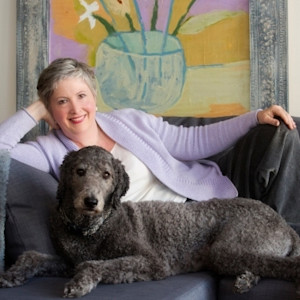
Jeannette Cooperman
Jeannette Cooperman has written several nonfiction books and a murder mystery, A Circumstance of Blood (Endeavour Press, 2015)—and yes, there’s a dog in it. She was a staff writer at St. Louis Magazine. She goes home to a century-old farmhouse in Waterloo, Ill., where she and her husband live with a standard poodle named Louie.
Related articles
![pet lover concept with mini dog on woman leg. sitting in room at home]() opens in a new tab
opens in a new tabWhat’s the Deal, Mouthy Puppies? Why Bite Inhibition Matters
How to teach your pup to play nice
![Two boxer dogs playing with a ball together in the park]() opens in a new tab
opens in a new tabDocked Tails Play a Role in Dog Communication
Looks aren’t everything, but they can talk
![Pet parent comforting anxious dog by holding their paw]() opens in a new tab
opens in a new tab8 Tips for Helping an Anxious Dog
Easy ways to calm your pup’s nerves
![A woman playing with her dog making a kiss face at it.]() opens in a new tab
opens in a new tabHere’s How You Can Avoid the Worst: a Dog Bite to the Face
Step one: never put your face close to theirs
